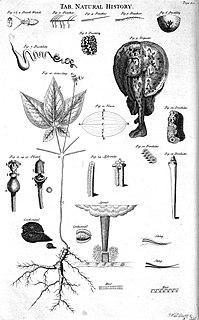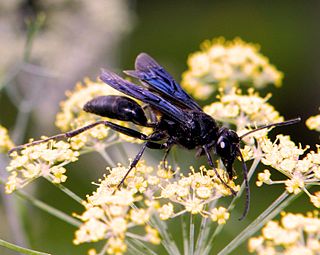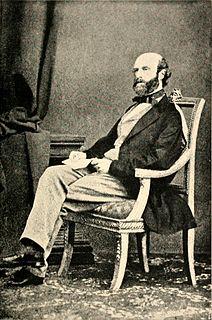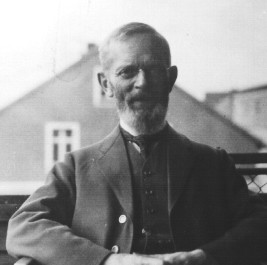Wilhelm von Winthem (1799–1847) was a naturalist and entomologist from Hamburg, Germany, who was chiefly interested in Diptera and Hymenoptera. Well placed in a port city, von Winthem built a world collection. [1] [2]

Natural history is a domain of inquiry involving organisms including animals, fungi and plants in their environment; leaning more towards observational than experimental methods of study. A person who studies natural history is called a naturalist or natural historian.

Hamburg is the second-largest city in Germany with a population of over 1.8 million.

Germany, officially the Federal Republic of Germany, is a country in Central and Western Europe, lying between the Baltic and North Seas to the north, and the Alps, Lake Constance and the High Rhine to the south. It borders Denmark to the north, Poland and the Czech Republic to the east, Austria and Switzerland to the south, France to the southwest, and Luxembourg, Belgium and the Netherlands to the west.
Winthem belonged to a long-established family of Hamburg merchants. A successful merchant himself he became very wealthy. He purchased huge numbers of insects, concentrating on Diptera, Hymenoptera and Hemiptera. [1] Johann Wilhelm Meigen worked on his European Diptera and he purchased the collection of Christian Rudolph Wilhelm Wiedemann (who had borrowed specimens from him including flies from Brazil), and many others. Thus he built the most important Diptera collection of the age.

Hymenoptera is a large order of insects, comprising the sawflies, wasps, bees, and ants. Over 150,000 living species of Hymenoptera have been described, in addition to over 2,000 extinct ones.

The Hemiptera or true bugs are an order of insects comprising some 50,000 to 80,000 species of groups such as the cicadas, aphids, planthoppers, leafhoppers, and shield bugs. They range in size from 1 mm (0.04 in) to around 15 cm (6 in), and share a common arrangement of sucking mouthparts. The name "true bugs" is sometimes limited to the suborder Heteroptera. Many insects commonly known as "bugs" belong to other orders; for example, the lovebug is a fly, while the May bug and ladybug are beetles.

Johann Wilhelm Meigen was a German entomologist famous for his pioneering work on Diptera.
- "For almost all the Diptera described in the present paper we are indebted to Wilhelm von Winthem of Hamburg, a young man who is collecting native and exotic insects with unusual enthusiasm and who has already made many welcome discoveries." — Wiedemann, 1819, Brasilianische Zweiflügler, Zoologisches Magazin (Kiel), 1(3):40-56.
Christian Rudolph Wilhelm Wiedemann, was a German physician, historian, naturalist and entomologist. He is best known for his studies of world Diptera, but he also studied Hymenoptera and Coleoptera, although far less expertly.
In 1852 his collection was sold to the Imperial Museum in Vienna. Kept separately until at least 1880 it was finally incorporated into the main Diptera collections of the Naturhistorisches Museum. Von Winthem's specimens are identified with a printed label "coll. Winthem", usually with the species name added and, appropriately, with Wiedemann's or Meigen's handwritten labels.

Vienna is the federal capital, largest city and one of nine states of Austria. Vienna is Austria's primate city, with a population of about 1.9 million, and its cultural, economic, and political centre. It is the 7th-largest city by population within city limits in the European Union. Until the beginning of the 20th century, it was the largest German-speaking city in the world, and before the splitting of the Austro-Hungarian Empire in World War I, the city had 2 million inhabitants. Today, it has the second largest number of German speakers after Berlin. Vienna is host to many major international organizations, including the United Nations and OPEC. The city is located in the eastern part of Austria and is close to the borders of the Czech Republic, Slovakia, and Hungary. These regions work together in a European Centrope border region. Along with nearby Bratislava, Vienna forms a metropolitan region with 3 million inhabitants. In 2001, the city centre was designated a UNESCO World Heritage Site. In July 2017 it was moved to the list of World Heritage in Danger.
In biology, a species ( ) is the basic unit of classification and a taxonomic rank of an organism, as well as a unit of biodiversity. A species is often defined as the largest group of organisms in which any two individuals of the appropriate sexes or mating types can produce fertile offspring, typically by sexual reproduction. Other ways of defining species include their karyotype, DNA sequence, morphology, behaviour or ecological niche. In addition, paleontologists use the concept of the chronospecies since fossil reproduction cannot be examined. While these definitions may seem adequate, when looked at more closely they represent problematic species concepts. For example, the boundaries between closely related species become unclear with hybridisation, in a species complex of hundreds of similar microspecies, and in a ring species. Also, among organisms that reproduce only asexually, the concept of a reproductive species breaks down, and each clone is potentially a microspecies.











